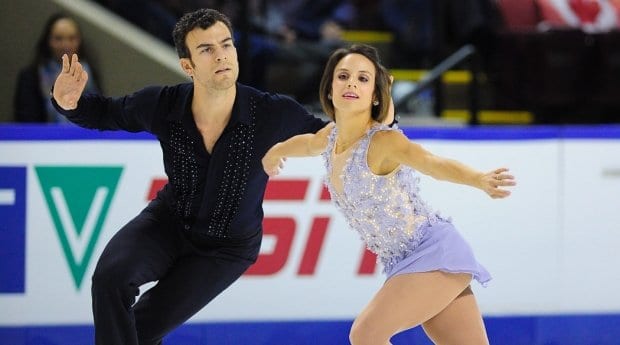Like many Olympians, Eric Radford’s chosen sport, figure skating, was a calling that spoke to him from the time he was a child. As his life became more and more devoted to the art and athleticism of his sport, it’s no surprise that his identity as a gay man informed his style as a skater.
“I saw the 1992 Olympics, and I was just drawn to it,” Radford says on the phone from his home in Montreal. “I told my mom, ‘I want to learn to do that.’ She put me in the CanSkate program, and it all started from there.”
Radford spent years away from his home in Red Lake, Ontario (about 500 kilometres northwest of Thunder Bay), living with host families in Winnipeg, Montreal and Toronto as he trained to become the best figure skater he could be.
Being away from family and constantly changing schools left him with few close friends outside figure skating.
“When it comes to accepting that I’m gay, without my parents around and changing schools every year, I didn’t really have a close circle of friends,” Radford says, before stopping himself. “It was skating that kept me out of trouble, kept me focused. Then by the time I did accept it myself and came out to my very closest friends, I had such a close and tight-knit group of friends from skating that were there to support me.”
Over the years, Radford moved from solo skating to pairs competition. He and his partner Meagan Duhamel are three-time Canadian national champions, and they helped bring home the silver medal in the team competition at the Sochi Olympics. They’re favourites in this year’s Grand Prix Final in Barcelona.
Although Radford has been out to friends and family since he was 18 and he makes no effort to hide his relationship with his partner, Normand, on his public Facebook page, he’s never had a moment where he’s stepped up to be counted as a gay athlete. That changed when the Canadian Olympic Committee launched its recent #OneTeam effort to fight homophobia in sport and in schools.
“In my immediate life it’s not a big deal because I feel like everybody knows,” Radford says. “But to put it out there for the people who don’t know me can send a strong and supportive message to anybody who’s going through that.”
He’s now the first figure skater to come out of the closet at the height of his competitive career. And while some athletes have worried that coming out might affect their scores in judged sports, Radford says he doesn’t think there’s any prejudice in skating.
“The environment is 100-percent accepting. I’ve never seen or had to deal with any sort of backlash for being gay,” he says.
But even if overt prejudice doesn’t creep into scores, pairs figure skating is a sport where a perceived (and often real) romantic connection between partners is a significant draw for fans and often plays a part in the performance on the ice. Think of famous pairs like Jamie Salé and David Pelletier or Tessa Virtue and Scott Moir.
“At first, I did worry about how coming out might affect how we’re perceived in having that connection on the ice, but there’s a difference between romance on the ice and connection on the ice. Despite me being gay, me and Meaghan’s connection is easy to see,” Radford says.
Not having romance over their heads allows the pair to focus on perfecting the technical elements and protects them from the fights that can trip up partners who do end up dating each other.
“It’s the movements you choose to tell your story,” Radford says. “We look into each other’s eyes, we hold each other’s hands, and we’re going through something amazing together without trying to tell the world that we want to make out. We’re out there together to give a really strong performance, but we tell it through the movements and executing our elements together, rather than me holding Meagan’s face or running my hand through her hair.”
But although Radford wants to inspire LGBT fans, he doesn’t want to be known as a “gay figure skater.”
“My story isn’t about being gay and having success,” Radford says. “It’s how despite whatever you have in your background, you can achieve whatever you put your mind to, whatever your dreams are.”


 Why you can trust Xtra
Why you can trust Xtra


